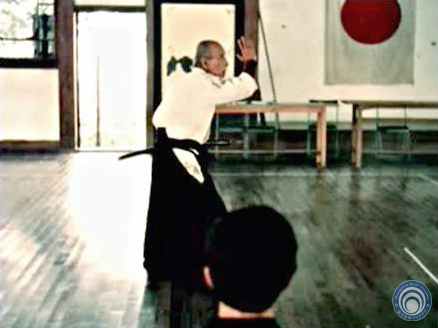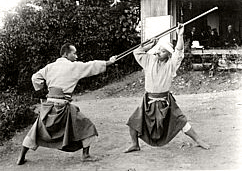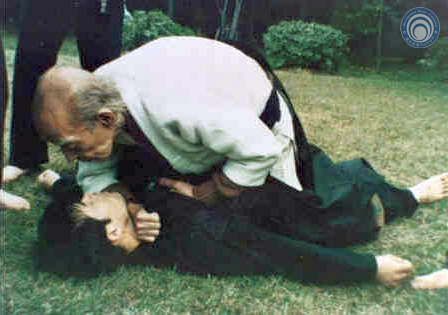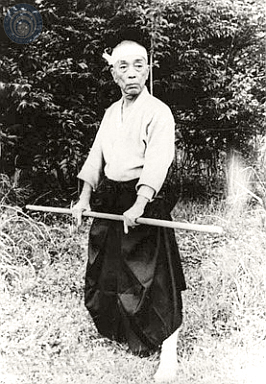Toshitsugu Takamatsu, whose birth name was Jutaro and real name Hisatsugu, later changed his name to Toshitsugu. He was commonly known as the Mouko no Tora (Mongolian Tiger), and took the names: Yokuou, Chosui, Kikaku, Shojuken, Garakuta Bujn, Kozan and Kyosha. He was born on March 10, 1889 in Hyogo prefecture as the first son of Takamatsu Gishin (Daiajari of Shingon Buddhism, leader of Gishin religious organization, owner of a match factory and politician), and passed away at the age of 85 on April 2, 1972 at his house in front of Kashihara shrine in Kashikara city, Nara prefecture. His posthumous name is Junshokakuju Zenjomon.

Takamatsu Sensei took the path of the martial-way at the age of 9, and practiced under Ishitani Matsutaro, Toda Shinryuken Masamitsu, and Mizuta Yoshitaro Tadafusa. He acquired the inner secrets of Hontai Yoshin Takagi ryu ju-jutsu, Kukishin ryu bo-jutsu, Tenshin Hyoho Kukishinden bujutsu, Gikan ryu koppo-jutsu, Shinden Fudo ryu jutaijutsu, daken-taijutsu, Shinden Tatara ryu taijutsu, Gyokko ryu kosshi-jutsu, Koto ryu koppo-jutsu, Tokakure ryu Ninpo and others, thus receiving complete transmission as the next generation.
Since the summer of 1910, at the age of 21, Toshitsugu entered the Maya mountain in Kobe to continue his rigorous practice dwelling in the mountains by the Kame no Taki water fall. He acquired spiritual transmission together with various inner secrets from the outstanding ascetic Tamaoki. This strengthened his mind and body.
Soon after leaving the mountain, Toshitsugu moved to Tien Qing in Quing Guo (China), and encountered life and death situations in true fighting when he walked from Manzhou to Beizhi. He won a match with Zhang Zi Long who was a Shaolin specialist. Later they became friends and maintained a good relationship. Toshitsugu also won a tournament for the purpose of selecting a chairman for the newly established Nippon Minkoku Seinen Butou-kai (Japanese Martial Arts Federation in China). After the tournament, Toshitsugu, as a chairman, taught the martial arts of Jujutsu to several thousand people.
In 1919, Toshitsugu returned to Japan and became a head-monk at a mountain temple of esoteric Buddhism in the Yamato district. Utilizing the power of esoteric Buddhism, he helped people who then respected him as a saint. Also, Toshitsugu took care of his foster mother Nao, without the help of others. Later, after she passed away, he cleansed her body.
Since 1921, Toshitsugu showed great respect to, and established a strong friendship with the 21st generation family-head Kuki Takaharu. It was similar to his father Gishin who maintained good relationships with the Kuki family. Toshitsugu was permitted to read and copy the inner secrets of Kuki Nakatomi. His devotion to copying and understanding of the inner secrets helped the research of Izumo hiki (another secret Tatara scrolls).

On February 11, 1921, viscount Kuki Takaharu established the Kodosenyokai. In October of 1929, he also built a dojo at the foot of Takamikura mountain. He called this dojo Kuki Shobukyoko and devoted his time teaching and further developing of Kuki Shinpo, Kukishin ryu bo-jutsu, and Kukishin ryu jujutsu. Takamatsu Toshitsugu especially adjusted Kukishin-ryu bo-jutsu and jujutsu from Tenshin Tatara Kn\angi-den bo-jutsu, Kusshoragi-den daken-taijutsu, Hontai Takagi Yoshin ryu and others. Toshitsugu, as a daihanshi and a Hossi, focused on speading, developing and teaching successors of Kukishin-ryu.
As a result of the air raids in 1945, most of the Kuki family documents were burned and lost. Thus Takamatsu Toshitsugu recopied the inner secrets from his own copy added explanations and dedicated it to the Kuki family on April 3, 1949. In may of 1950, Toshitsugu Takamatsu established Kashihara Shobukai in Nara prefecture. In the post-War era Takamatsu spent his time developing successors to his martial tradition. At the same time, he often sponsored Magokuro-kai-musubi tsudoi meeting and lectures about Amatsu Tatara, especially Izumo Shinpo, and reared many martial artists and religious leaders. Among his disciples were Masaji Kimura, Fumio Akimoto, Kimbei Sato, Takashi Ueno, Yoshiaki Hatsumi (Ueno's personal student) and others.

Time Line:
1908 - Received Menyko Kaiden for Shinden Fudo ryu, Koto ryu, and Togakure ryu from Toda Shinryuken
1909 - Toda dies
1910 - Ishitani dies
1914 - Establishes Japanese martial arts federation in China
1919 - Returns from China
1919 - Kimura becomes student of Takamatsu
1919 - Becomes tendai priest
1920 - Takamatsu Sensei copies Kuki clan scrolls
1938 - Takamatsu Sensei grants Kimura menkyo kaiden for Kukishin ryu bojutsu and jujutsu
1945 - Kuki clan scrolls destroyed during WW 2
1949 - Presented new scrolls to Kuki family
1952 - Takamatsu Sensei grants Sato Kimbei menkyo kaiden for Takagi Yoshin ryu and Kukishin ryu
1962 - Akimoto dies
1963 - Takamatsu Sensei grants Sato Kimbei menkyo kaiden for Gikan ryu
1972 - Takamatsu Sensei dies


 On February 11, 1921, viscount Kuki Takaharu established the Kodosenyokai. In October of 1929, he also built a dojo at the foot of Takamikura mountain. He called this dojo Kuki Shobukyoko and devoted his time teaching and further developing of Kuki Shinpo, Kukishin ryu bo-jutsu, and Kukishin ryu jujutsu. Takamatsu Toshitsugu especially adjusted Kukishin-ryu bo-jutsu and jujutsu from Tenshin Tatara Kn\angi-den bo-jutsu, Kusshoragi-den daken-taijutsu, Hontai Takagi Yoshin ryu and others. Toshitsugu, as a daihanshi and a Hossi, focused on speading, developing and teaching successors of Kukishin-ryu.
On February 11, 1921, viscount Kuki Takaharu established the Kodosenyokai. In October of 1929, he also built a dojo at the foot of Takamikura mountain. He called this dojo Kuki Shobukyoko and devoted his time teaching and further developing of Kuki Shinpo, Kukishin ryu bo-jutsu, and Kukishin ryu jujutsu. Takamatsu Toshitsugu especially adjusted Kukishin-ryu bo-jutsu and jujutsu from Tenshin Tatara Kn\angi-den bo-jutsu, Kusshoragi-den daken-taijutsu, Hontai Takagi Yoshin ryu and others. Toshitsugu, as a daihanshi and a Hossi, focused on speading, developing and teaching successors of Kukishin-ryu.




